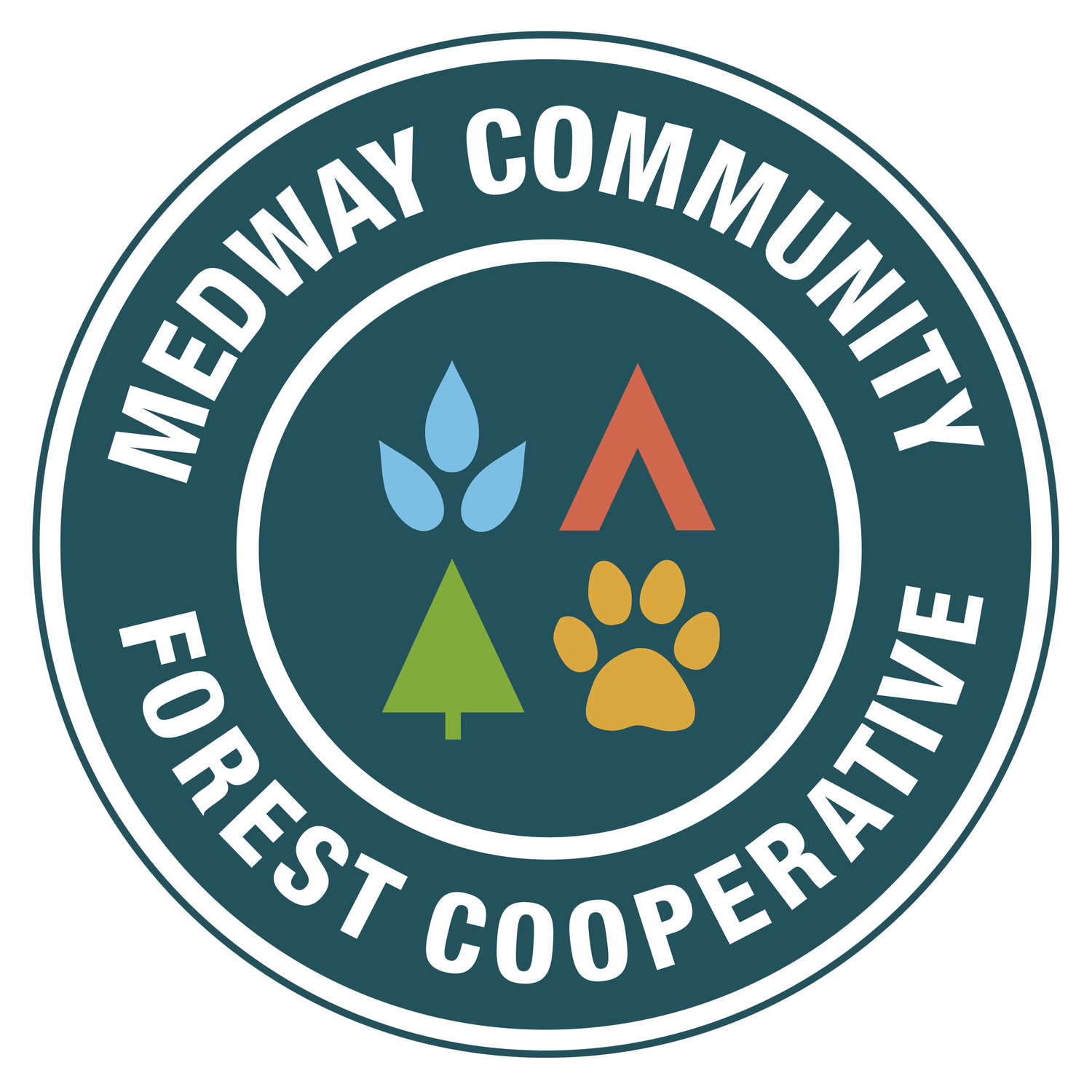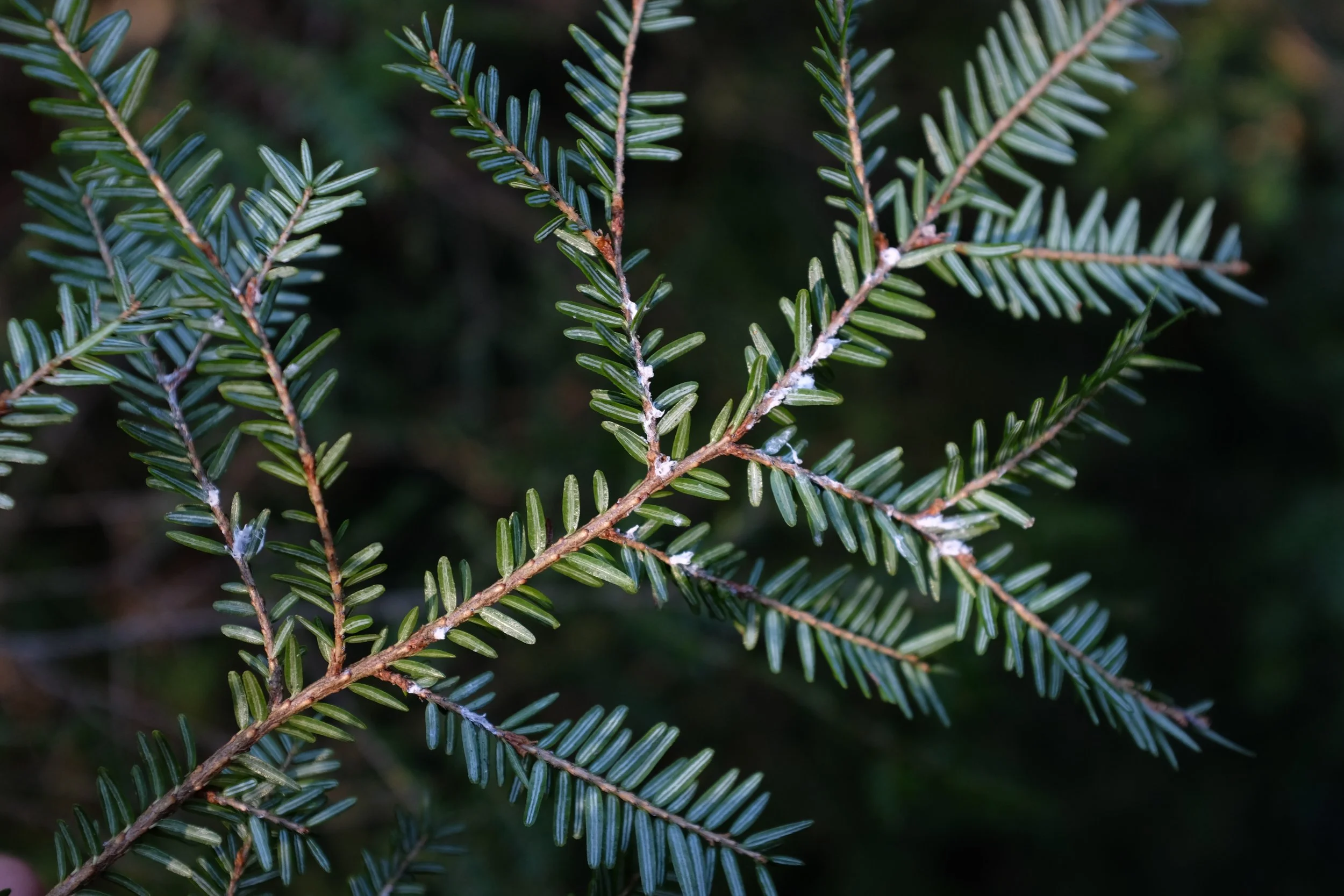
Medway Community Forest Cooperative’s
Hemlock Conservation Program
Eastern Hemlocks Need Your Help!
The Value of Eastern Hemlock
Eastern hemlock is the longest-lived and largest conifer tree in the Wabana’ki-Acadian Forest. It can exceed 1m in diameter at breast height and forms tall, closed-canopy protective networks overhead that instill a sense of awe and, for some, a spiritual connection or cathedral-like experience. Hemlock are an important species for many reasons. They are extremely tolerant of shade, which allows their seedlings to establish in the understory and perpetuate on the same sites for thousands of years. They are adapted to small gap disturbances and windthrow events that expose bare mineral soil for ideal seedling establishment.
Hemlocks have the capacity to modify their forest environment, which earns them recognition as a ‘foundation species.’ Tree branches weave a protective web of dense canopy that shuts out light and creates its own microclimate of high humidity. In cold winter storms, it holds the warmth of the earth and intercepts snow and freezing rains, a valuable shelter to white-tailed deer, moose, and other wildlife species. In summer, the densely shaded understory can foster a microclimate up to 10 degrees Celsius cooler than temperatures above the canopy. The unique ecological role and function of hemlock cannot be replaced by any other tree.
The loss of hemlock extends far beyond the trees to great losses of associated and hemlock-dependent species.
Our Strike Team
The MCFC has adopted a ‘Strike Team model’ approach that has been used effectively throughout areas of USA to conserve hemlocks. A Strike Team is a skilled and highly trained operational crew who conducts hemlock health assessments and administers small amounts of chemicals that are designed to operate inside the trees to control HWA infestations.
The Hemlock Conservation Strike Team will operate for nine months each year through the next four years, consisting of 3-4 staff, coordinated by Jessica Ihlen. Focus is placed on treating some of the most high-value and oldest hemlocks remaining within protected areas of the province.
Despite valiant efforts by provincial government staff and the MCFC, the invasive HWA is rapidly infesting and killing Eastern Hemlock forests in seven southwestern counties. Strike teams will conserve only a small fraction of our once vast hemlock forests.
The Hemlock Conservation Strike Team makes a plan for treating old growth hemlock in Medway Lakes Wilderness Area.
Our Objective
To conserve and protect high-value and old growth Eastern Hemlock forests against the invasive insect, Hemlock Woolly Adelgid (HWA) (Adelges tsugae) throughout protected areas in Nova Scotia. We take effective action to maintain healthy hemlock forests for future generations.
Our Funding
Our HWA program is part of a collaborative project with The Nova Scotia Department of Environment and Climate Change and the Department of Natural Resources and Renewables to treat hemlocks across southwestern Nova Scotia. Financial support is contributed by both Departments and Environment and Climate Change Canada through the Nature Smart Climate Solutions Fund.
Resources
Image: Infected Eastern Hemlock tree with Adelges tsugae
What is Hemlock Woolly Adelgid?
Hemlock Woolly Adelgid (Adelges tsugae) or ‘HWA’ is a tiny invasive insect. It attacks and kills eastern hemlock trees by feeding on the water and nutrient storage cells at the base of the needles. The insect, itself, is almost too small to see (pepper flake-sized), but white, woolly growth secreted by each female as she grows makes her become more visible through late winter-spring.
HWA can kill hemlock in 3-10 years. Areas of Nova Scotia where winters are mildest appear to experience more rapid mortality. HWA feeds for most of the winter underneath the branch tips on the newest growth. The insects are all female, each capable of laying fertile eggs. HWA produces two generations each year.
Once a hemlock stand becomes infested, the race ensues to conserve trees before the canopy drops its needles and becomes too thin to treat.
Resources for Landowners
With funding from the Department of Environment And Climate Change Canada, the MCFC developed this video series aimed at arming land stewards with the skills and information they need to safely and effectively protect hemlock trees against the invasive Hemlock Woolly Adelgid (HWA).
The full five-part video series is available on our YouTube channel.
Resources for Practitioners
The MCFC has been active in various research projects to develop mitigation strategies for HWA since it was first detected in NS. We have focused our approach on the sustainable chemical treatment of hemlock trees through the Hemlock Conservation Program, as well as partnered with federal government to investigate the response of HWA to silviculture thinning treatments.
In 2022, the MCFC was hired by NS Environment and Climate Change to develop a recommendations to develop an execute a hemlock chemical treatment program for southwestern NS. The report is a vital resources for practitioners who are interested in building a chemical control program. Check our website often for new updates and resources as they become publicly available.



